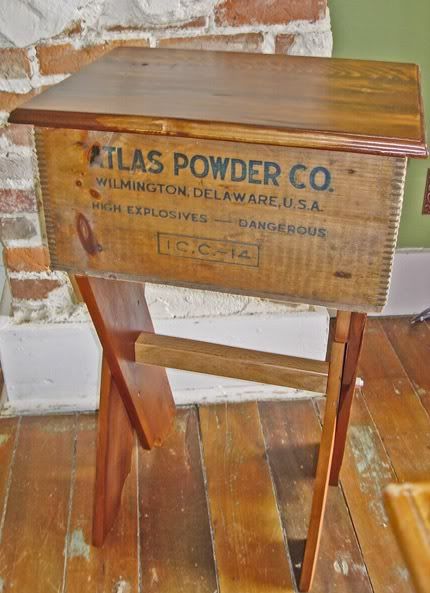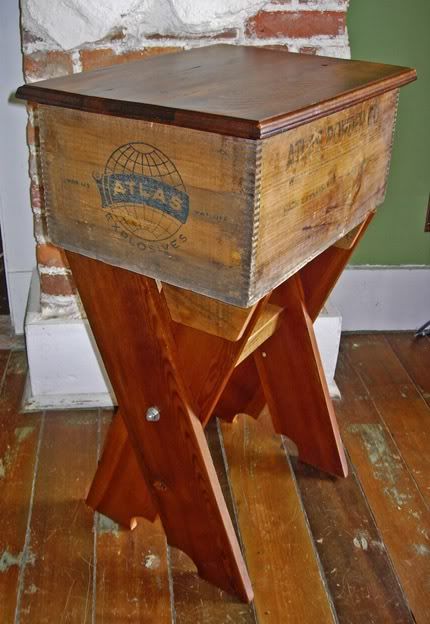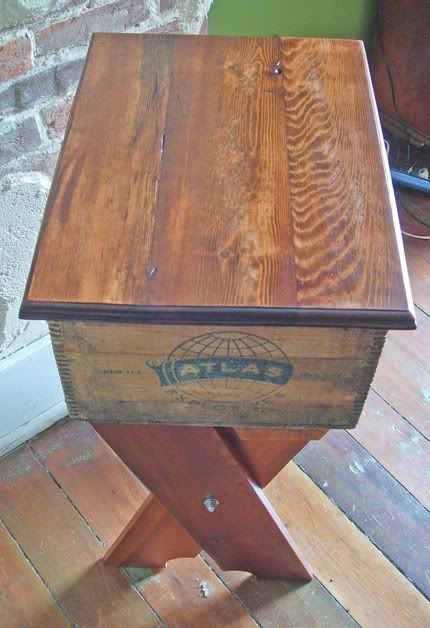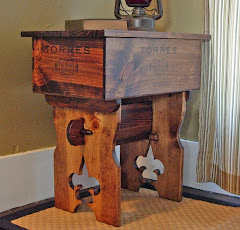 Dad found me this old Atlas Powder Company crate at a flea market a while ago. I knew I'd make a table out of it, similar to the Wine Crate end tables I've been doing.
Dad found me this old Atlas Powder Company crate at a flea market a while ago. I knew I'd make a table out of it, similar to the Wine Crate end tables I've been doing.I finally settled on a scissor leg design, with a trestle bar.
I wanted this to look both somewhat rustic, and a bit industrial at the same time. I was going for a look that felt as though it might have been assembled out of available materials at an exploratory mining encampment some time in the past.
To support that theme, I went with exposed nuts and washers on the outside of the cross legs, instead of the mortise and tenon joint I used with the wine crate tables. Since the legs overlap each other, I couldn't use the single broad cleat to hold the legs to the bottom of the crate. Instead, I made a pair of chevron shaped cleats for each end and attached them so that one would be seen from the outside, and the other would be hidden by a leg.
 All the parts of the lamp table are salvaged material. The top and legs are made from very old pine planks from a set of shelving my grandmother used to hold homemade jelly and preserves in her basement. The growth rings in these boards are so tight and so numerous, that I can't count them. I suppose I could with a magnifying glass and a stylus, but it would take a while.
All the parts of the lamp table are salvaged material. The top and legs are made from very old pine planks from a set of shelving my grandmother used to hold homemade jelly and preserves in her basement. The growth rings in these boards are so tight and so numerous, that I can't count them. I suppose I could with a magnifying glass and a stylus, but it would take a while.You just can't find wood like this now a days. Rings like this indicate a very slow growing and very old tree. We largely wasted the old growth forests of north America on frivolous crap that chokes the land fills now. But I suppose that's a rant for another day.
 I gave the top a coat of Minwax Provencal stain, a medium dark and my personal favorite. I them sanded most of it off after it had dried. I purposely took off more stain in some areas than in others, to increase the variation in the appearance of the top.
I gave the top a coat of Minwax Provencal stain, a medium dark and my personal favorite. I them sanded most of it off after it had dried. I purposely took off more stain in some areas than in others, to increase the variation in the appearance of the top. I really prefer the hand made look to furniture, and most other things really. I like it to the point of leaving dings, scratches and other damage in old materials so that they are obvious in the furniture I make from them.
I sold high end furniture for a long time, and I eventually realized I didn't much care for it. I think it's a problem that our culture of mass manufacture has made people intolerant of imperfection, and unable to appreciate the individual character of things that are made one at a time.
Mass production makes items available to greater numbers of people at a reduced cost, but it also reduces the value of the items produced. Nobody cares about the coffee table they got at Target, there's a million others just like it getting chucked in dumpsters when their badly designed joints give out.
Sorry, ranting again. Heh...
 Anyway, I gave the top a few brushed coats of satin polyurethane, so that it would wear better. The powder box itself, I only gave a single thin sprayed coat. I wanted it to retain all of it's worn and faded appeal and remain distinct from the top and legs. The legs got two brushed coats as well.
Anyway, I gave the top a few brushed coats of satin polyurethane, so that it would wear better. The powder box itself, I only gave a single thin sprayed coat. I wanted it to retain all of it's worn and faded appeal and remain distinct from the top and legs. The legs got two brushed coats as well. As with the wine crate tables, the top comes off so that the crate is available for storage.
As with the wine crate tables, the top comes off so that the crate is available for storage.The end of the crate is marked with "50, 4x16, Atlas Apex C, 15, 516, H.V.", I know the 5o means 50 lbs, and I assume the 4x16 refers to the size of the sticks of explosive the crate contained.
I haven't been able to find an identical crate online. Atlas made explosives for a variety of applications, but most of the crates I've seen were for coal mining explosives like Coalite. I know they ceased operations in the 60's, but from the condition of the crate, I believe it at least dates from the 40's.
If anyone can identify the age of the crate more accurately, I would appreciate hearing from you.






